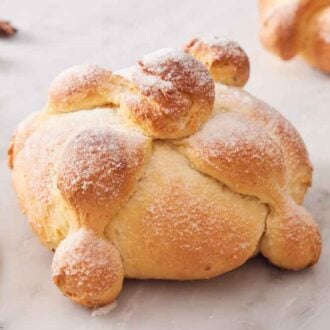
Pan de Muerto
Pan de Muerto is a classic bread made for the November 1st and 2nd Mexican holiday, Diá de Los Muertos. These orange and anise-spiced loaves are lightly sweet, fluffy, and an integral part of the Mexican holiday that celebrates and honors relatives and ancestors who have passed.
Servings 8 servings
Calories 563kcal
Ingredients
- ½ cup whole milk (120g)
- 1 cup unsalted butter room temperature and divided (227g)
- 4½ cups all-purpose flour divided (562g)
- 1 tablespoon instant yeast (9g)
- ⅔ cup granulated sugar divided (133g)
- 3 large eggs
- 1 tablespoon orange zest (1 large orange)
- 1 tablespoon orange blossom water
- 1½ teaspoons anise seeds
- 1 teaspoon salt
Instructions
- In a small saucepan over medium-low heat, heat the milk and butter, stirring occasionally, until the butter is melted and an instant-read thermometer registers 110F-115F. Pour the milk mixture into the bowl of a stand mixer. Add the yeast and ½ cup flour, stirring gently until combined. Cover, and let rest at room temperature until mixture is very bubbly, 45 minutes to an hour.
- Add the remaining 4 cups flour, ⅓ cup sugar, eggs, zest, orange blossom water, anise, and salt to yeast mixture. Using the paddle attachment on low speed, mix ingredients until combined.
- Switch to the dough hook attachment, and knead the dough on low speed until smooth and elastic, 6 to 8 minutes. Transfer the dough to a lightly floured surface and shape into a ball. Place the dough in a lightly oiled bowl, cover, and let rise until doubled in size, 45 minutes to an hour.
- Line a large sheet pan with parchment paper.
- Punch down the risen dough. On a lightly floured surface, portion off about a quarter of the dough (about 256g). Divide that small portion in half. Cover and set aside.
- Divide the remaining larger portion of dough in half (about 385g each). Shape each half into a smooth ball, then press down gently to flatten slightly until it has roughly a 5-inch diameter. Place both rounds on the prepared baking sheet several inches apart.
- Take one of the reserved small portions of dough. Cut off a small piece, and roll it into a 1-inch ball. Cut the remaining dough in half and shape each piece into 7-inch ropes. Press a finger across each rope to create three evenly spaced indentations in the dough. (These will act as the “bones” that sit on the bread.)
- Place a “bone” down the center of one of the large dough rounds. Place the other bone on top, running perpendicular to the first, overlapping in the center. Place the 1-inch dough on top in the center where the bones cross, pressing gently to adhere. Repeat with the remaining reserved dough and large dough round. Cover loosely with plastic wrap or a damp tea towel, and let the loaves rise until puffed, 30 to 45 minutes.
- Preheat oven to 350°F.
- Bake for 30 to 35 minutes or until the crust is a deep golden brown. Carefully transfer the loaves to a wire rack and cool for 10 minutes.
- Meanwhile, heat the remaining ½ cup of butter in the microwave in 20-second intervals until melted. Brush the warm loaves with butter, and evenly sprinkle with the remaining ⅓ cup of granulated sugar. Let cool completely. Store at room temperature in an airtight container for up to 3 days.
Notes
- Don’t overheat the milk. The milk and butter mixture must only be heated to 110-115 degrees Fahrenheit. Any warmer, and you risk killing the yeast. Use an instant-read food thermometer when heating the milk and butter to know when to remove the pan from the heat.
- Proof in a warm, but not hot, area. You want to place the bread in a location that is around 75-81 degrees Fahrenheit but no warmer, or you will risk overproofing. Some great proofing locations are on top of the refrigerator, in a sunlit spot, or even in an oven with the light turned on but the heat turned off.
- Melt the butter in short intervals. Prevent splattering and burns by melting the butter in a small bowl in short microwave intervals before brushing on the bread. If your microwave is particularly strong, you may want to set the microwave to half power when melting.
- Optional: Manually knead the dough. This recipe can also be made without a stand mixer. Stir the warm milk and butter together with the eggs, orange blossom water, zest, and dry ingredients with a wooden spoon until combined and a craggy mass has formed. Turn out the dough on a lightly floured surface and knead by hand for 7-10 minutes, or until the dough is elastic and smooth, adding sprinkles of additional flour if needed to keep it from sticking to your hands or the surface.
- Optional: Mold different bread shapes. Get creative by shaping skulls, animals, or even angels. If creating different shapes, you may need to separate the dough into different size balls than directed in the recipe, so create a plan for your desired shapes and separate the bread dough accordingly before shaping.
Nutrition
Calories: 563kcal | Carbohydrates: 72g | Protein: 11g | Fat: 26g | Saturated Fat: 16g | Polyunsaturated Fat: 2g | Monounsaturated Fat: 7g | Trans Fat: 1g | Cholesterol: 133mg | Sodium: 328mg | Potassium: 143mg | Fiber: 2g | Sugar: 18g | Vitamin A: 839IU | Vitamin C: 1mg | Calcium: 51mg | Iron: 4mg